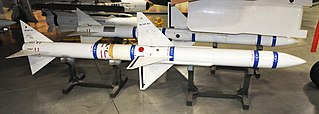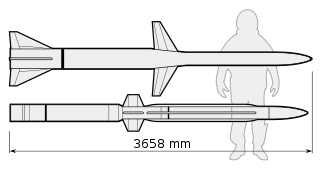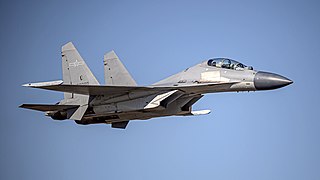Related Research Articles

The AIM-7 Sparrow is an American medium-range semi-active radar homing air-to-air missile operated by the United States Air Force, United States Navy, United States Marine Corps, and various other air forces and navies. Sparrow and its derivatives were the West's principal beyond visual range (BVR) air-to-air missile from the late 1950s until the 1990s. It remains in service, although it is being phased out in aviation applications in favor of the more advanced AIM-120 AMRAAM.
The AIM-120 Advanced Medium-Range Air-to-Air Missile(AMRAAM) ( AM-ram) is an American beyond-visual-range air-to-air missile capable of all-weather day-and-night operations. It uses active transmit-receive radar guidance instead of semi-active receive-only radar guidance. When an AMRAAM missile is launched, NATO pilots use the brevity code "Fox Three".

Fighter aircraft are military aircraft designed primarily for air-to-air combat. In military conflict, the role of fighter aircraft is to establish air superiority of the battlespace. Domination of the airspace above a battlefield permits bombers and attack aircraft to engage in tactical and strategic bombing of enemy targets.

The Rafael Python (פיתון) is a family of air-to-air missiles (AAMs) built by the Israeli weapons manufacturer Rafael Advanced Defense Systems, formerly RAFAEL Armament Development Authority. Originally starting with the Shafrir series, the Shafrir-1 missile was developed in 1959, followed by the Shafrir-2 in early 1970s. Subsequently, the missiles were given the western name of "Python" by the parent company for export purposes, starting with the Python-3 in 1978. Since then, it has been further developed and evolved into the Python-4, Python-5, Derby and also, the SPYDER, an advanced ground-based air-defence system. Currently, the missiles are in service with the armed forces of over fifteen countries from around the world.

An air-to-air missile (AAM) is a missile fired from an aircraft for the purpose of destroying another aircraft. AAMs are typically powered by one or more rocket motors, usually solid fueled but sometimes liquid fueled. Ramjet engines, as used on the Meteor, are emerging as propulsion that will enable future medium- to long-range missiles to maintain higher average speed across their engagement envelope.

The Vympel NPO R-77 missile is a Russian active radar homing beyond-visual-range air-to-air missile. It is also known by its export designation RVV-AE. It is the Russian counterpart to the American AIM-120 AMRAAM missile.

The Vympel K-13 is a short-range, infrared homing air-to-air missile developed by the Soviet Union. It is similar in appearance and function to the American AIM-9B Sidewinder from which it was reverse-engineered. Although it since has been replaced by more modern missiles in frontline service, it saw widespread service in many nations.

The Hughes AIM-4 Falcon was the first operational guided air-to-air missile of the United States Air Force. Development began in 1946; the weapon was first tested in 1949. The missile entered service with the USAF in 1956.
A beyond-visual-range missile is an air-to-air missile that is capable of engaging at ranges of 20 nmi (37 km) or beyond. This range has been achieved using dual pulse rocket motors or booster rocket motor and ramjet sustainer motor.

The Vympel R-37 is a Russian hypersonic air-to-air missile with very long range. The missile and its variants also had the names K-37, izdeliye 610 and RVV-BD, and the NATO codenames "Axehead" and "Andi". It was developed from the R-33.

The PL-12 is an active radar-guided beyond-visual-range air-to-air missile developed by the People's Republic of China. It is considered comparable to the US AIM-120 AMRAAM and the Russian R-77.

The AIM-152 Advanced Air-to-Air Missile (AAAM) was a long-range air-to-air missile developed by the United States. The AIM-152 was intended to serve as the successor to the AIM-54 Phoenix. The program went through a protracted development stage but was never adopted by the United States Navy, due to the ending of the Cold War and the reduction in threat of its perceived primary target, Soviet supersonic bombers. Development was cancelled in 1992.
The Mitsubishi AAM-4 is a medium-range active radar homing air-to-air missile. It is a modern beyond-visual-range missile developed in Japan and intended to replace the semi-active radar homing AIM-7 Sparrow missile in service. It has been operational since 1999. The main contractor is Mitsubishi Electric. The 2010 AAM-4B was the world's first air-to-air missile with an AESA radar seeker.

The Shenyang J-16 is a Chinese advanced fourth-generation, tandem-seat, twinjet, multirole strike fighter developed from the Shenyang J-11 and built by Shenyang Aircraft Corporation. It is operated by the People's Liberation Army Air Force (PLAAF).
A sixth-generation fighter is a conceptualized class of jet fighter aircraft design more advanced than the fifth-generation jet fighters that are currently in service and development. Several countries have announced the development of a national sixth-generation aircraft program, including the United States, Russia and China, while Japan, Italy, the United Kingdom, France, Germany, Spain, and Sweden have joined together in collaborative multinational programs in an effort to spread development costs. The first sixth-generation fighters are expected to enter service in the 2030s.
Cooperative Engagement Capability (CEC) is a sensor network with integrated fire control capability that is intended to significantly improve battle force air and missile defense capabilities by combining data from multiple battle force air search sensors on CEC-equipped units into a single, real-time, composite track picture. This will greatly enhance fleet air defense by making jamming more difficult and allocating defensive missiles on a battle group basis.
The PL-21 or PL-XX is an active radar-guided beyond-visual-range air-to-air missile developed by the People's Republic of China. It is considered comparable to the American AIM-260 JATM, and the Russian R-37 (missile).

The PL-15 is an active radar-guided long-range air-to-air missile developed by the People's Republic of China.
The AIM-260 Joint Advanced Tactical Missile (JATM) is an American beyond-visual-range air-to-air missile (BVRAAM) under development by Lockheed Martin. Designed to address advanced threats, the missile is expected to replace or supplement the AIM-120 AMRAAM currently in US service. The United States Department of Defense (DoD) considers the AIM-260A JATM program to be the number one air-delivered weapon priority for both the Air Force and the Navy; and its acquisition out-prioritizes other weapon system improvements and modernization efforts on any fielded aircraft.
The PL-17 or PL-20 is an active radar-guided beyond-visual-range air-to-air missile developed by the People's Republic of China for the People's Liberation Army Air Force (PLAAF). The missile has claimed range of 400 km (250 mi) and is intended to target larger targets such as tanker and early warning and control (AEW&C) aircraft.
References
- ↑ "F-15EX to Carry New Oversized Air-To-Air Missile - Todayuknews". 17 May 2021.
- ↑ Rogoway, Tyler (2 November 2017). "The Pentagon Is Quietly Developing A Next Generation Long-Range Air-To-Air Missile".
- ↑ Pike, John. "LREW (long-range engagement weapon)". www.globalsecurity.org.
- ↑ "New long-range missile project emerges in US budget". 2 November 2017.
- ↑ "Meet The AIM-260, The Air Force And Navy's Future Long-Range Air-To-Air Missile". The War Zone. 22 June 2019. Retrieved 21 July 2019.